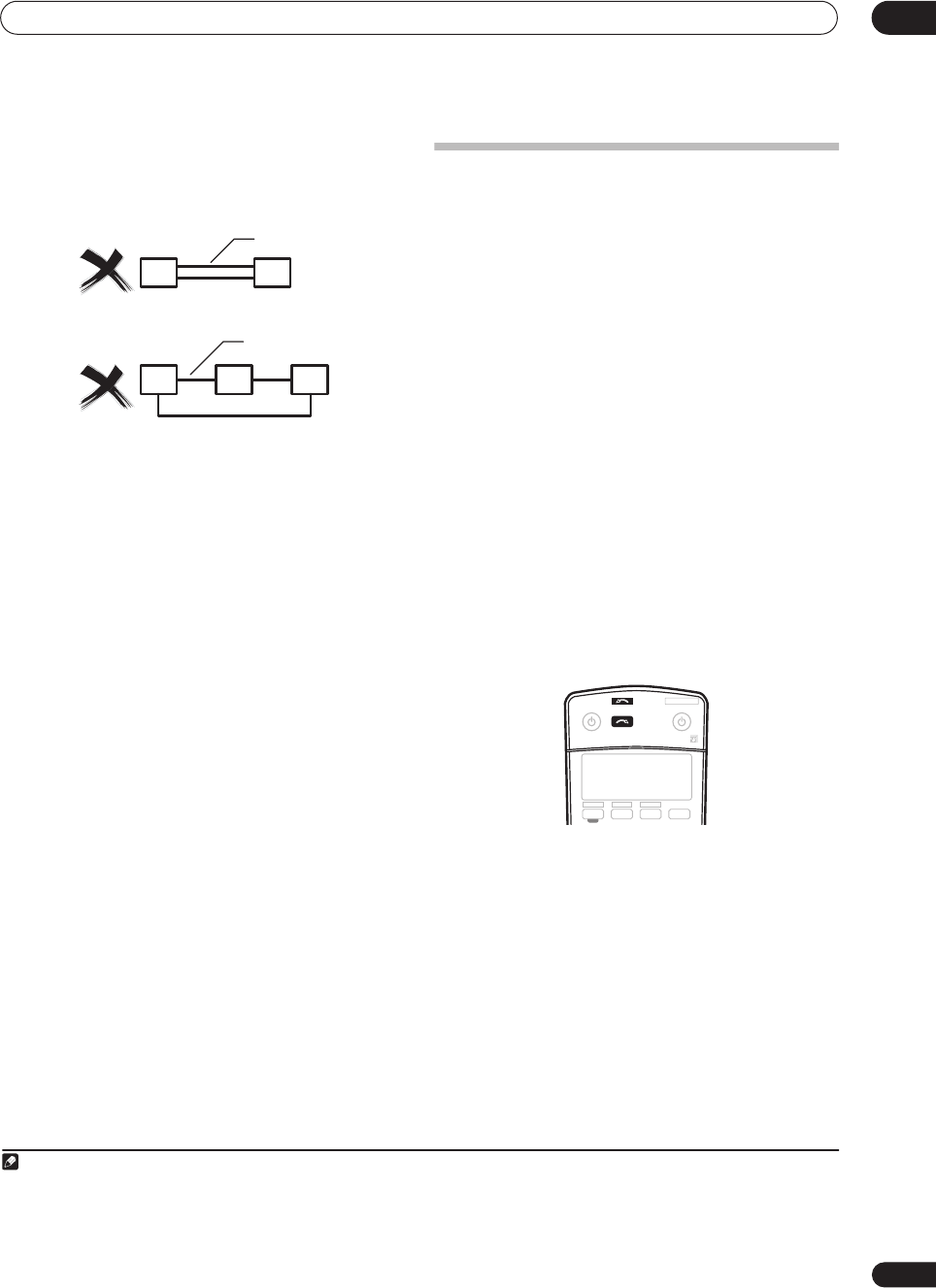
Other connections
08
51
En
The system will not work if the connected components
form a loop. If a loop is detected, the message
LOOP
CONNECT
shows in the display. Figs. 3 and 4 show
connections that form a loop.
Another consideration when connecting i.LINK devices
is the speed of the interface. At present there are three
speeds; S100 (slowest), S200 and S400 (fastest). This
receiver uses the S400 type. Although you can use
components with different speeds together, we
recommend connecting slower-speed components at
the edge of the network if possible (shown by the shaded
boxes in figs. 1 and 2). This will keep the network free of
bottlenecks.
When used within an i.LINK network, this receiver must
be on for the i.LINK connection to be maintained. Other
components in the network may or may not maintain the
connection in standby (none will when the power is
completely off)—check the operating instructions
supplied with individual components. Note that the audio
may be momentarily interrupted if a component in the
i.LINK network is switched on/off, or its i.LINK
connection is switched on/off.
This product complies with the following i.LINK interface
specifications:
1) IEEE Std. 1394a-2000, Standard for a High Performance
Serial Bus
2) Audio and Music Data Transmission Protocol 2.0
Following the standard for AM824 sequence adaptation
layers, the product is compatible with IEC60958 bitstream,
DVD-A and SACD.
Connecting the multichannel analog inputs
For DVD Audio and SACD playback, your DVD player may
have 5.1, 6.1 or 7.1 channel analog outputs (depending
on whether your player supports surround back
channels).
1
Make sure that the player is set to output
multichannel analog audio.
1 Connect the front, surround, center and subwoofer
outputs on your DVD player to the corresponding
MULTI CH input jack on this receiver.
• Use standard RCA/phono jack cables for the
connections.
2 If your DVD player also has outputs for surround
back channels, connect these to the corresponding
MULTI CH input jacks on this receiver.
• Use standard RCA/phono jack cables for the
connections.
• If there is a single surround back output, connect it to
the
SURROUND BACK L (Single)
jack on this
receiver.
Selecting the multichannel analog inputs
If you have connected a decoder or a DVD player as
above, you must select the analog multichannel inputs
for surround sound playback.
2
1 Make sure you have set the playback source to the
proper output setting.
For example, you might need to set your DVD player to
output multichannel analog audio.
2 Use the INPUT SELECT button to select MULTI CH IN.
You can also use the
INPUT SELECTOR
dial on the front
panel.
• Depending on the DVD player you’re using, the
analog output level of the subwoofer channel may be
too low. In this case switch the receiver into standby,
then press
STANDBY/ON
while holding down
VIDEO SELECT
on the front panel. This switches
between
SW IN +10dB
(increase of 10 decibels) and
SW IN 0dB
(default) in the subwoofer channel.
fig. 3
fig. 4
i.LINK cable
i.LINK cable
Note
1 To listen to multichannel analog audio you’ll need to switch the input signal selector to
MULTI CH INPUT
(see
Selecting the multichannel analog inputs
above for more on this).
2• When playback from the multichannel inputs is selected, you can’t use Midnight/Loudness, Dialog Enhancement or the
SIGNAL SELECT
and
ANA-
LOG ATT
buttons, as well as any of the listening modes (including
STEREO
and the surround back channel processing).
• When playback from the multichannel inputs is selected, only the volume and channel levels can be set.
• You can’t listen to your speaker B (Second Zone) system during playback from the multichannel inputs.
RECEIVER SOURCE
SYSTEM OFF
INPUT
SELECT
DVD SAT
VIDEO 1 TV CONT
CD TV VIDEO 2
VSX_74TXVi.book.fm 51 ページ 2005年6月6日 月曜日 午後7時8分


















